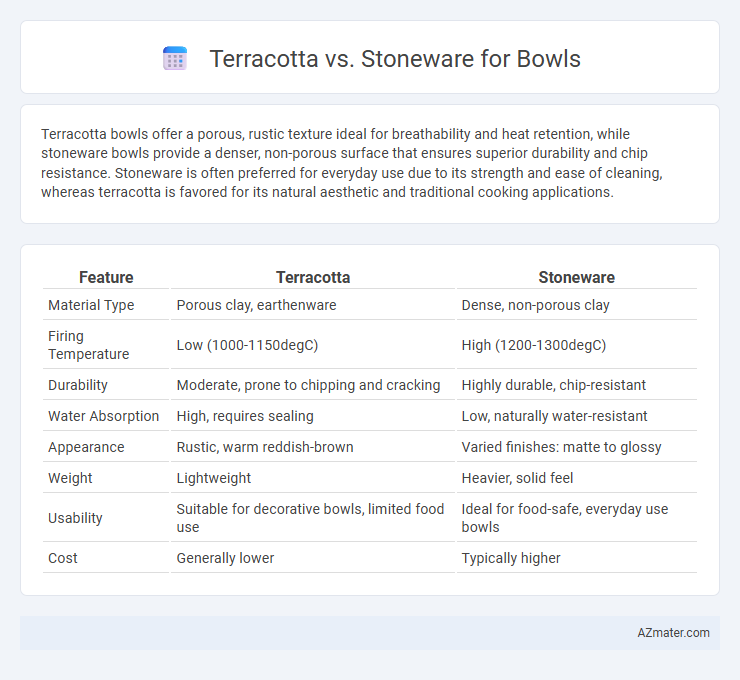Terracotta bowls offer a porous, rustic texture ideal for breathability and heat retention, while stoneware bowls provide a denser, non-porous surface that ensures superior durability and chip resistance. Stoneware is often preferred for everyday use due to its strength and ease of cleaning, whereas terracotta is favored for its natural aesthetic and traditional cooking applications.
Table of Comparison
| Feature | Terracotta | Stoneware |
|---|---|---|
| Material Type | Porous clay, earthenware | Dense, non-porous clay |
| Firing Temperature | Low (1000-1150degC) | High (1200-1300degC) |
| Durability | Moderate, prone to chipping and cracking | Highly durable, chip-resistant |
| Water Absorption | High, requires sealing | Low, naturally water-resistant |
| Appearance | Rustic, warm reddish-brown | Varied finishes: matte to glossy |
| Weight | Lightweight | Heavier, solid feel |
| Usability | Suitable for decorative bowls, limited food use | Ideal for food-safe, everyday use bowls |
| Cost | Generally lower | Typically higher |
Introduction to Terracotta and Stoneware Bowls
Terracotta bowls are made from porous clay fired at lower temperatures, offering a rustic aesthetic and excellent breathability ideal for serving and cooking. Stoneware bowls, produced from dense clay fired at higher temperatures, provide superior durability, non-porosity, and resistance to chipping, making them suitable for everyday use and oven-safe applications. Both materials offer distinct functional and visual qualities, with terracotta emphasizing traditional warmth and stoneware delivering modern robustness.
Material Composition and Properties
Terracotta bowls are made from porous, low-fired clay that retains moisture well but is less durable and more prone to chipping compared to stoneware. Stoneware bowls are crafted from a dense, high-fired clay body that is non-porous, making them highly resistant to heat, scratches, and everyday wear. The mineral composition of stoneware often includes feldspar and quartz, providing superior strength and a vitrified surface, while terracotta's iron-rich clay results in its characteristic reddish-brown color and earthy texture.
Aesthetic Differences: Texture and Color
Terracotta bowls feature a warm, earthy texture with a porous surface that absorbs natural hues of red, orange, or brown, offering a rustic, handcrafted aesthetic. Stoneware bowls present a smoother, denser texture with a glazed finish in a variety of colors, from muted neutrals to vibrant shades, providing a polished and contemporary look. The color palette of terracotta remains rooted in natural clay tones, while stoneware allows for greater versatility through glazing techniques and color customization.
Durability and Strength Comparison
Stoneware bowls exhibit superior durability and strength due to their dense, non-porous composition, making them resistant to chipping and cracking under heavy use. Terracotta, while naturally porous and more fragile, can be strengthened through glazing, but remains more prone to breakage and wear over time. The higher firing temperature of stoneware results in a harder, more resilient surface ideal for daily kitchen use.
Heat Retention and Cooking Performance
Stoneware bowls offer superior heat retention due to their dense, vitrified structure, making them ideal for slow-cooked dishes and maintaining warmth during meals. Terracotta bowls, being more porous, heat up quickly but lose warmth faster, which suits recipes requiring rapid temperature changes or serving cold dishes. Stoneware's durability and even heat distribution enhance cooking performance, while terracotta provides rustic charm and breathability but demands careful handling to avoid cracking under thermal stress.
Porosity and Water Resistance
Terracotta bowls exhibit higher porosity, resulting in greater water absorption and lower water resistance, making them less ideal for holding liquids over extended periods. Stoneware bowls feature low porosity and superior water resistance, providing durability and moisture retention suitable for everyday use. The denser composition of stoneware ensures less seepage and enhanced longevity compared to the porous, more breathable structure of terracotta.
Suitability for Different Cuisines
Terracotta bowls are ideal for slow-cooked stews, soups, and rustic Mediterranean or Indian dishes due to their porous nature, which retains moisture and adds subtle earthy flavors. Stoneware bowls suit a wider range of cuisines, including Western, Asian, and baked dishes, as they offer durability, even heat distribution, and non-porous surfaces that prevent staining and absorb odors. Choosing between terracotta and stoneware depends on cooking style: terracotta excels in moisture retention and flavor infusion, while stoneware provides versatility and ease of maintenance for diverse culinary uses.
Maintenance and Cleaning Tips
Terracotta bowls require gentle handling and should be washed by hand with warm water and mild soap to prevent cracking and preserve their porous nature. Stoneware bowls are more durable and dishwasher-safe, making cleaning easier while resisting stains and odors better than terracotta. To maintain both materials, avoid using abrasive scrubbers and ensure bowls are thoroughly dried before storage to prolong their lifespan.
Cost Considerations and Availability
Terracotta bowls are generally more affordable due to the lower cost of raw materials and simpler manufacturing processes, making them widely accessible in local markets. Stoneware bowls, although typically pricier, offer greater durability and are often available in specialty or high-end stores, reflecting their higher firing temperatures and denser composition. Cost variations between terracotta and stoneware also depend on regional availability, with terracotta more common in Mediterranean and Asian regions, while stoneware is prevalent in Western pottery markets.
Which Bowl Should You Choose?
Terracotta bowls offer a rustic charm with excellent heat retention, ideal for slow cooking and serving warm dishes, but they are more porous and may require sealing to prevent absorption. Stoneware bowls provide superior durability, are non-porous, and often dishwasher-and-microwave safe, making them practical for everyday use with less maintenance. Choosing between terracotta and stoneware depends on your preference for aesthetic warmth versus functional sturdiness.

Infographic: Terracotta vs Stoneware for Bowl
 azmater.com
azmater.com